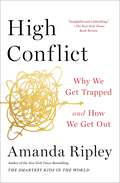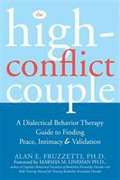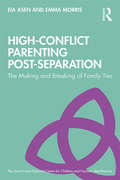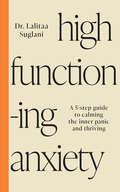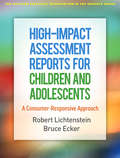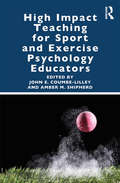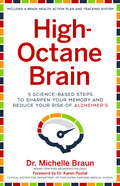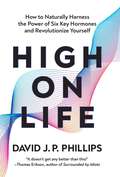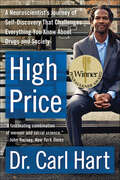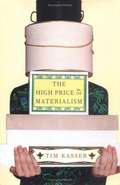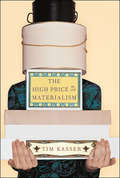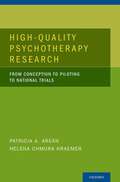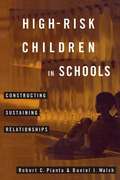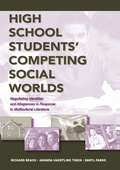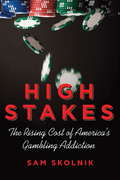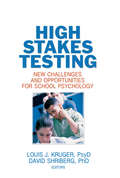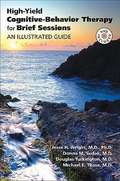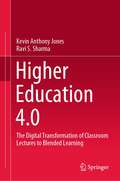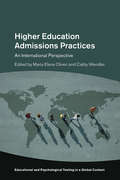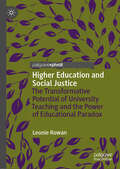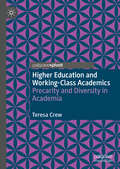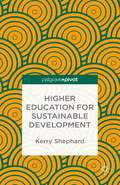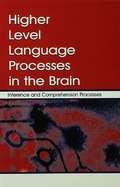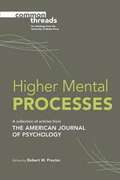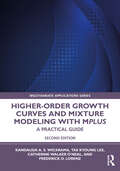- Table View
- List View
High Conflict: Why We Get Trapped and How We Get Out
by Amanda RipleyWhen we are baffled by the insanity of the &“other side&”—in our politics, at work, or at home—it&’s because we aren&’t seeing how the conflict itself has taken over.That&’s what &“high conflict&” does. It&’s the invisible hand of our time. And it&’s different from the useful friction of healthy conflict. That&’s good conflict, and it&’s a necessary force that pushes us to be better people. High conflict is what happens when discord distills into a good-versus-evil kind of feud, the kind with an us and a them. In this state, the brain behaves differently. We feel increasingly certain of our own superiority, and everything we do to try to end the conflict, usually makes it worse. Eventually, we can start to mimic the behavior of our adversaries, harming what we hold most dear. In this &“compulsively readable&” (Evan Osnos, National Book Award-winning author) book, New York Times bestselling author and award-winning journalist Amanda Ripley investigates how good people get captured by high conflict—and how they break free. Our journey begins in California, where a world-renowned conflict expert struggles to extract himself from a political feud. Then we meet a Chicago gang leader who dedicates his life to a vendetta—only to realize, years later, that the story he&’d told himself about the conflict was not quite true. Next, we travel to Colombia, to find out whether thousands of people can be nudged out of high conflict at scale. Finally, we return to America to see what happens when a group of liberal Manhattan Jews and conservative Michigan corrections officers choose to stay in each other&’s homes in order to understand one another better, even as they continue to disagree. All these people, in dramatically different situations, were drawn into high conflict by similar forces, including conflict entrepreneurs, humiliation, and false binaries. But ultimately, all of them found ways to transform high conflict into good conflict, the kind that made them better people. They rehumanized and recategorized their opponents, and they revived curiosity and wonder, even as they continued to fight for what they knew was right. People do escape high conflict. Individuals—even entire communities—can short-circuit the feedback loops of outrage and blame, if they want to. This is an &“insightful and enthralling&” (The New York Times Book Review) book—and a mind-opening new way to think about conflict that will transform how we move through the world.
The High Conflict Couple: A Dialectical Behavior Therapy Guide To Finding Peace, Intimacy, And Validation
by Alan E. FruzzettiIf you are part of a "high-conflict" couple, you need to get control of your emotions first, to stop making things worse, and only then work on building a better relationship. The High-Conflict Couple adapts the powerful techniques of dialectical behavior therapy (DBT) into skills you can use to tame out-of-control emotions that flare up in your relationship. Using mindfulness and distress tolerance techniques, you'll learn how to deescalate angry situations before they have a chance to explode into destructive fights. Other approaches will help you disclose your fears, longings, and other vulnerabilities to your partner and validate his or her experiences in return. You'll discover ways to manage problems with negotiation, not conflict, and to find true acceptance and closeness with the person you love the most.
High-Conflict Parenting Post-Separation: The Making and Breaking of Family Ties (The Anna Freud National Centre for Children and Families)
by Eia Asen Emma MorrisHigh-Conflict Parenting Post-Separation: The Making and Breaking of Family Ties describes an innovative approach for families where children are caught up in their parents’ acrimonious relationship - before, during and after formal legal proceedings have been initiated and concluded. This first book in a brand-new series by researchers and clinicians at the Anna Freud National Centre for Children and Families (AFNCCF) outlines a model of therapeutic work which involves children, their parents and the wider family and social network. The aim is to protect children from conflict between their parents and thus enable them to have healthy relationships across both ‘sides’ of their family network. High-Conflict Parenting Post-Separation is written for professionals who work with high-conflict families – be that psychologists, psychiatrists, child and adult psychotherapists, family therapists, social workers, children’s guardians and legal professionals including solicitors and mediators, as well as students and trainees in all these different disciplines. The book should also be of considerable interest for parents who struggle with post-separation issues that involve their children.
High-Functioning Anxiety: A 5-Step Guide to Calming the Inner Panic and Thriving
by Dr. Lalitaa SuglaniDo you always show up for everyone else, get praised for your strength, and look like you have it all together while secretly experiencing intense worry, self-doubt, or fear of failure? Do you work hard to please others while feeling disconnected from the &‘real you&’? People with high-functioning anxiety (HFA) often appear competent and accomplished on the outside, but internally, it&’s a very different story. HFA is rooted in fear – the fear of others seeing the &‘real&’ us – and can lead to a cycle of overworking, overthinking, and self-criticism. Award-winning psychologist Dr Lalitaa is here to tell you that you don&’t have to live like this anymore. Weaving together scientific research with practical exercises and case studies, Dr Lalitaa offers a five-step plan that will radically shift how you see yourself. You&’ll discover: · the main symptoms of high-functioning anxiety and how they emerge in daily behaviour · the two sides of high-functioning anxiety: how you see yourself vs. how you present yourself to the world · how to release old modes of thinking and habitual thought patterns and replace them with healthy attitudes · practical methods for creating and sustaining long-term lifestyle changes, so that you can calm the inner panic, find balance, and thrive This transformational book will show you how to break the toxic cycle of high-functioning anxiety – for good.
High-Impact Assessment Reports for Children and Adolescents: A Consumer-Responsive Approach (The Guilford Practical Intervention in the Schools Series)
by Robert Lichtenstein Bruce EckerAssessment provides rich opportunities for understanding the needs of children and adolescents, yet reports are often hard for parents, teachers, and other consumers to comprehend and utilize. This book provides step-by-step guidelines for creating psychoeducational and psychological reports that communicate findings clearly, promote collaboration, and maximize impact. Effective practices for written and oral reporting are presented, including what assessment data to emphasize, how to organize reports and convey test results, and how to craft useful recommendations. In a large-size format with lay-flat binding for easy photocopying, the book includes sample reports, training exercises, and reproducible templates, rubrics, and forms. Purchasers get access to a Web page where they can download and print the reproducible materials. This book is in The Guilford Practical Intervention in the Schools Series, edited by T. Chris Riley-Tillman.
High Impact Teaching for Sport and Exercise Psychology Educators
by John E. Coumbe-Lilley Amber M. ShipherdHigh Impact Teaching for Sport and Exercise Psychology Educators addresses the need for a resource on effective course design, assessment, content delivery, and classroom management that is specific to educators in the field of sport and exercise psychology and to working with the millennial learner. It provides discipline-specific ideas to improve teaching in higher education. The book provides an evidence-based guide of tried and tested teaching methods for teachers of sport and exercise psychology at all levels in all formats of education. Irrespective of the level and prior teaching experience in sport and exercise psychology, this is a starting point for delivering significant learning experiences for students in this field of study. Second, it addresses the millennial learner and recommends future teaching and learning experiences in traditional, hybrid, and online formats. Finally, High Impact Teaching for Sport and Exercise Psychology Educators provides a positive approach to engaging students in an ongoing process of learning and involvement in the field of sport and exercise psychology. This book is intended for any educator in a 2- or 4-year institution of higher education who is or will be teaching courses at the undergraduate or graduate level in sport and exercise psychology as well as students and practitioners in the areas of sport and exercise psychology and physical education.
High-Octane Brain: 5 Science-Based Steps to Sharpen Your Memory and Reduce Your Risk of Alzheimers
by Michelle BraunFrom a Harvard- and Yale-trained neuropsychologist, a science-backed five-step program to boost memory and dramatically decrease the risk of Alzheimer’s. American adults fear Alzheimer’s more than any other disease—including cancer—and because many don’t realize there is no genetic cause for 99 percent of Alzheimer’s cases, they don’t take the necessary steps to change lifestyle factors shown to significantly protect against the disease. In this book, board-certified neuropsychologist Dr. Michelle Braun inspires you to make lasting improvements by explaining the truth about brain health and providing expert guidance through the maze of conflicting media advice on supplements, brain games, nutrition, and exercise. Braun interviews eight leading brain health experts, combining their insights with cutting-edge research to offer proven strategies to implement the five steps of the High-Octane Brain. Interactive exercises help you develop a personalized program for optimal brain health. Dr. Braun also provides a tracking system with a visual depiction of progress, and shows the High-Octane Brain plan in action through the lives of clients. Packed with valuable tips you can implement immediately to minimize common “brain blips,” exercises to boost your memory within minutes, and inspiring insights from nine High-Octane Brain role models ages 44 to 103, this groundbreaking book helps put the future of your brain in your control.“Thorough, backed up by the best available research, and accessible.” —Barry Gordon, M.D., Ph.D., Director, Cognitive Neurology/Neuropsychology Division, Department of Neurology, Johns Hopkins Medical Institutions and University
High on Life: How to Naturally Harness the Power of Six Key Hormones and Revolutionize Yourself
by David J. PhillipsA revolutionary guide to optimizing your brain and becoming the best version of yourself. "A hands-on manual for influencing human happiness through your own biology. It doesn't get any better than this!"—Thomas Erikson, author of Surrounded by Idiots: The Four Types of Human BehaviorNeurochemicals affect just about everything in our bodies, including how we think and feel. David J. P. Phillips, an internationally acclaimed Swedish public speaker and coach, guides you through ways to harness the immense power of your mind and optimize your body's chemical factory by diving deep into six neurochemicals and how they can transform your life from within. Already an international bestseller, High on Life is a mood manual that will guide you through how to use these six key substances naturally produced by your body to create a unique recipe to transform your life. If you're struggling to feel motivated or finding it hard to enjoy the small things in life, learning how to balance dopamine will help you feel more motivated. Dialing up your oxytocin will fill your cup up with compassion, generosity and a sense of connectedness with the world and people around you. If the mood rollercoaster is something you desperately want to get off, focus on serotonin, the hormone that serves as a foundation of long-lasting happiness and harmony. Feeling good but missing that extra nudge to challenge yourself a bit more? Cortisol produced in small doses can help you break out of your comfort zone—and get excited about it. When nothing really happens, anyone can get a little bit bored. Have a laugh, smile more, or sweat it out and get those endorphins flowing. Or if you want to walk into an important meeting oozing confidence, testosterone is your ally. Just be careful not to boost it when making important life decisions. A mood manual that will transform how we think and feel, this book is for anyone who wants to feel high on life—naturally.
High Price: A Neuroscientist's Journey of Self-Discovery That Challenges Everything You Know About Drugs and Society
by Carl HartHigh Price is the harrowing and inspiring memoir of neuroscientist Carl Hart, a man who grew up in one of Miami’s toughest neighborhoods and, determined to make a difference as an adult, tirelessly applies his scientific training to help save real lives. Young Carl didn't see the value of school, studying just enough to keep him on the basketball team. Today, he is a cutting-edge neuroscientist—Columbia University’s first tenured African American professor in the sciences—whose landmark, controversial research is redefining our understanding of addiction.In this provocative and eye-opening memoir, Dr. Carl Hart recalls his journey of self-discovery, how he escaped a life of crime and drugs and avoided becoming one of the crack addicts he now studies. Interweaving past and present, Hart goes beyond the hype as he examines the relationship between drugs and pleasure, choice, and motivation, both in the brain and in society. His findings shed new light on common ideas about race, poverty, and drugs, and explain why current policies are failing.
The High Price of Materialism
by Tim KasserTim Kasser offers a scientific explanation of how our contemporary culture of consumerism and materialism affects our everyday happiness and psychological health.
The High Price of Materialism
by Tim KasserA study of how materialism and consumerism undermine our quality of life.In The High Price of Materialism, Tim Kasser offers a scientific explanation of how our contemporary culture of consumerism and materialism affects our everyday happiness and psychological health. Other writers have shown that once we have sufficient food, shelter, and clothing, further material gains do little to improve our well-being. Kasser goes beyond these findings to investigate how people's materialistic desires relate to their well-being. He shows that people whose values center on the accumulation of wealth or material possessions face a greater risk of unhappiness, including anxiety, depression, low self-esteem, and problems with intimacy—regardless of age, income, or culture.Drawing on a decade's worth of empirical data, Kasser examines what happens when we organize our lives around materialistic pursuits. He looks at the effects on our internal experience and interpersonal relationships, as well as on our communities and the world at large. He shows that materialistic values actually undermine our well-being, as they perpetuate feelings of insecurity, weaken the ties that bind us, and make us feel less free. Kasser not only defines the problem but proposes ways we can change ourselves, our families, and society to become less materialistic.
High-Quality Psychotherapy Research: From Conception to Piloting to National Trial
by Patricia A. Arean Helena Chmura Kraemerlthough psychotherapy research shares many of the same methodological issues that pharmacology trials do, psychotherapy research poses unique challenges, including the difficulty (if not near impossibility) of keeping participants blind to treatment assignment, the need for a replicable manual and therapist training procedure, the importance of outside observation of therapy quality ratings, and the problems researchers face in measuring the active ingredients of psychotherapy. High-Quality Psychotherapy Research is for all psychotherapy investigators who wish to learn state-of-the-art psychotherapy research methods. Organized developmentally, the book explains the conceptualization of the trial, discusses the pilot study and the large scale study, and concludes with instructions for designing a multi-site trial. Topics specific to psychotherapy research are examined in detail, including innovations in data analysis, how to conduct multi-site psychotherapy trials, mediation of treatment outcomes, the transportability of evidence-based behavioral interventions in community practice, training community providers to be study therapists, and recruiting hard-to-reach populations. High-Quality Psychotherapy Research is an informative, practical book appropriate for a broad range of readers, from junior investigators developing their first study idea to seasoned investigators who wish to take their research to a larger-scale level.
High-Risk Children In Schools: Constructing Sustaining Relationships
by Robert Pianta Daniel WalshHigh Risk Children in Schools offers a way for psychologists and educators to see and talk about the growing population of "at-risk" children--those likely to fail at formal schooling--while helping to redefine the relationship between schools and families. Using systems theory and developmental psychology, the authors present a new framework for the study and education of children who are at-risk. This framework--the Contextual Systems Model--creates a dialogue between the child and schooling through which meaning, goals, and experiences are shared and accepted.
High School Students' Competing Social Worlds: Negotiating Identities and Allegiances in Response to Multicultural Literature
by Richard Beach Amanda Haertling Thein Daryl L. ParksThis book examines how working-class high school students’ identity construction is continually mediated by discourses and cultural practices operating in their classroom, school, family, sports, community, and workplace worlds. Specifically, it addresses how responding to cultural differences portrayed in multicultural literature can serve to challenge adolescents’ allegiances to status quo discourses and cultural models, and how teachers not only can rouse students to clarify and change their value stances related to race, class, and gender, but also provide support for and validation of students’ self-interrogation. Highlighting the influence of sociocultural forces, the book contributes to understanding the role of institutions in shaping adolescents’ lives, and identifies needs that must be addressed to improve those institutions. Current theory and research on critical discourse analysis, cultural models theory, and identity construction is meshed with specific applications of that theory and research to case-study profiles and analysis of classroom discussions. The instructional strategies described enable pre-service and in-service teachers to develop their own literature curriculum and instructional methods.
High Stakes: The Rising Cost of America's Gambling Addiction
by Sam SkolnikAmerica is becoming hooked on gambling. From the millions of dens and dorm rooms lit by online poker games to the neighborhoods transformed by new casinos and slot machine parlors, legalized gambling has become an integral part of our lives. With a singular blend of investigative journalism and poignant narratives of gambling addiction, award-winning journalist Sam Skolnik provides an in-depth exploration of the consequences of this national phenomenon. The result is High Stakes, an unflinching look at the explosive growth of legalized gambling in our country, the concurrent rise of addicted gamblers, and what it all means. Thirty-five years ago, casinos were legal in just one state, Nevada. Today, legalized gambling has morphed into a $92 billion industry established in all but two states. As elected officials are urging voters to expand gambling's reach, the industry's supporters and their equally impassioned detractors are squaring off in prolonged state-by-state battles. Millions of Americans are being asked to decide: Are the benefits worth the costs? Industry officials and their political allies assert that gambling is an effective way to raise revenue and create jobs. But these rewards come at a steep price. Fast-rising numbers of addicted gamblers are causing higher indebtedness and bankruptcy rates, as well as increased divorces, suicides, and gambling-related crime. Skolnik shows how the gambling industry is targeting Asian Americans--and why this population, more than any other ethnic group, is likely to develop gambling problems. He also illustrates how gambling has helped turn Las Vegas into America's most dysfunctional community, and how the upsurge of poker and Internet gambling has created a new generation of gambling junkies. In High Stakes, we meet politicians eager to promote legalized gambling as an economic cure-all, scientists wrestling with the meaning of gambling addiction, and ensnared players so caught up in the chase that they've lost their livelihoods and their minds. Throughout it all, Skolnik--an avid poker player--never loses sight of the human side of these struggles.From the Hardcover edition.
High Stakes Testing: New Challenges and Opportunities for School Psychology
by Louis J. Kruger David ShribergMeet the challenges of high stakes testing in the practice of school psychology School psychologists can be a positive influence on how students, teachers, parents, schools, and communities cope with the challenges and opportunities associated with high stakes testing. Unfortunately, there has been a significant lack of literature to guide school psychologists and related school-based practitioners on this topic. High Stakes Testing: New Challenges and Opportunities for School Psychology is a timely groundbreaking book that provides useful and thought-provoking information to help psychologists meet the challenges of high stakes testing and create new roles for themselves in helping children succeed. This book discusses practical ways to help provide academic support to facilitate student success on high stakes tests, reduce the impact of stress associated with high stakes testing, assess the data from the tests to improve programs, and take a leadership role in the appropriate use of the tests. The No Child Left Behind Act of 2001(NCLB) and its accountability provisions has helped create and sustain a climate where student performance on state-created achievement tests often has high stakes implications for students, families, and schools. High Stakes Testing: New Challenges and Opportunities for School Psychology provides important background information about high stakes testing, including the legal, historical, and political context of high stakes testing, pertinent psychometrics, and a review of research on academic and non-academic outcomes as it relates to high stakes testing. Using this information as a foundation, the book then identifies new roles and opportunities for school psychologists with respect to high stakes testing. This book is comprehensively referenced. Topics in High Stakes Testing: New Challenges and Opportunities for School Psychology include: advocating for the appropriate use of state-wide assessments the influence of item response theory (IRT) on the development of high stakes tests whether the accountability system of NCLB is truly improving student&’s learning the impact of high stakes tests on classroom instruction and student motivation strategies for helping students succeed on high stakes tests available resources to cope with the stress of high stakes testing and more High Stakes Testing: New Challenges and Opportunities for School Psychology is a thought-provoking, horizon-expanding resource for school psychologists, public school educators, administrators, school counselors, curriculum coordinators, and special education teachers involved in organizing, administering, and preparing students to take high stakes tests.
High-Yield Cognitive-Behavior Therapy for Brief Sessions: An Illustrated Guide
by Jesse H. Wright Douglas Turkington Donna M. Sudak Michael E. ThaseHigh-Yield Cognitive-Behavior Therapy for Brief Sessions: An Illustrated Guide breaks entirely new ground in explaining how to weave together the powerful tools of CBT with pharmacotherapy in sessions shorter than the traditional "50-minute hour. " Written for psychiatrists, therapists, and other clinicians, the book details ways to enrich brief sessions with practical CBT interventions that work to relieve symptoms and promote wellness. An engaging and instructive resource of video illustrations included with the book demonstrates how to successfully implement brief CBT sessions for some of the most common and important problems seen in clinical practice -- depression, anxiety, psychotic symptoms, suicidality, sleep disturbances, substance abuse, and coping with physical health issues. Written by practicing clinicians with extensive experience in combining CBT and pharmacotherapy, this volume builds on the constructs and techniques described in the authors' earlier best-selling illustrated guides, Learning Cognitive-Behavior Therapy and Cognitive-Behavior Therapy for Severe Mental Illness. The authors describe in detail the general features of CBT that can be applied in less time than the 50-minute hour #149; The therapist and patient function as an investigative team; the power of this collaborative empiricism can be evident in even the shortest of clinical encounters. #149; Clinicians teach patients how to rapidly set agendas, focus on specific problems, pace sessions, and give and receive feedback on progress; this structuring approach is especially well-suited to brief sessions. #149; A basic tenet of CBT, psychoeducation can effectively be delivered in sessions shorter than 45-60 minutes and, in fact, may become a more dominant aspect of treatment during briefer time frames. #149; Patients can learn practical, high-yield methods for decreasing symptoms fairly quickly, making these methods highly suitable for application in shorter sessions. #149; Homework extends learning beyond the confines of the session and encourages self-help in the treatment process, effectively increasing the value of shortened clinician-patient time. When sessions are brief, clinicians must be able to generate succinct and targeted formulations that include key pieces of information that allow for full understanding of the patient, while honing in on specific problems where positive results can be collaboratively pursued. This book, with its video illustrations and learning exercises, was designed to help readers achieve incisive formulations while they sharpen their basic CBT techniques and successfully apply this knowledge in the stimulating and rewarding domain of brief sessions. A must-read for working clinicians as well as trainees, this book offers pragmatic solutions for the challenge of providing effective psychotherapy in brief treatment sessions.
Higher Education 4.0: The Digital Transformation of Classroom Lectures to Blended Learning
by Kevin Anthony Jones Sharma RavishankarThis book chronicles a 10-year introduction of blended learning into the delivery at a leading technological university, with a longstanding tradition of technology-enabled teaching and learning, and state-of-the-art infrastructure. Hence, both teachers and students were familiar with the idea of online courses. Despite this, the longitudinal experiment did not proceed as expected. Though few technical problems, it required behavioural changes from teachers and learners, thus unearthing a host of socio-technical issues, challenges, and conundrums. With the undercurrent of design ideals such as “tech for good”, any industrial sector must examine whether digital platforms are credible substitutes or at best complementary. In this era of Industry 4.0, higher education, like any other industry, should not be about the creative destruction of what we value in universities, but their digital transformation. The book concludes with an agenda for large, repeatable Randomised Controlled Trials (RCTs) to validate digital platforms that could fulfil the aspirations of the key stakeholder groups – students, faculty, and regulators as well as delving into the role of Massive Open Online Courses (MOOCs) as surrogates for “fees-free” higher education and whether the design of such a HiEd 4.0 platform is even a credible proposition. Specifically, the book examines the data-driven evidence within a design-based research methodology to present outcomes of two alternative instructional designs evaluated – traditional lecturing and blended learning. Based on the research findings and statistical analysis, it concludes that the inexorable shift to online delivery of education must be guided by informed educational management and innovation.
Higher Education Admissions Practices: An International Perspective (Educational and Psychological Testing in a Global Context)
by María Elena Oliveri Cathy WendlerThis book provides a path for resolving challenges related to access, diversity, equity, and other issues facing higher education admissions. It illuminates current higher education admissions practices in a global context, highlighting common obstacles. The chapters outline decision-making models used in college admissions, details those assessments commonly employed in admissions, and provides innovative perspectives on the future of admissions. The book's multidisciplinary approach defines much-needed changes in admissions brought about by shifts in the makeup of student populations and in higher education itself. Rationales for moving away from traditional assessments used in admissions and expanding the criteria used to ensure a student's academic success are discussed. Readers will come away with an understanding of the current issues, philosophies, and historical circumstances facing higher education admissions across the globe and will be equipped to contemplate and react to future possibilities and opportunities.
Higher Education and Social Justice: The Transformative Potential of University Teaching and the Power of Educational Paradox
by Leonie RowanThis book demonstrates how the pedagogical decision making of university academics can be shaped by engagement with an educational philosophy known as “relationship-centred education”. Beginning with critical analysis of concepts such as student engagement, student satisfaction, and student-centred learning, the author goes on to investigate how literature relating to social justice challenges educators to consider these terms in particular ways. From this basis, the book explores the factors featuring in inclusive, respectful, diverse and student-centred environments. In analysing these factors, the author illuminates the perspectives of university teachers who struggle with the unique challenges of working in the academy; including an increasingly broad set of employment demands and narrower criteria for determining ‘impact’, all while retaining focus on the transformative potential of higher education. This book will be of interest to students and scholars of transformative learning, as well as social justice within higher education.
Higher Education and Working-Class Academics: Precarity and Diversity in Academia
by Teresa CrewThis book examines how a working-class habitus interacts with the elite culture of academia in higher education. Drawing on extensive qualitative data and informed by the work of Pierre Bourdieu, the author presents new ways of examining impostor syndrome, alienation and microaggressions: all common to the working-class experience of academia. The book demonstrates that the term ‘working-class academic’ is not homogenous, and instead illuminates the entanglements of class and academia. Through an examination of such intersections as ethnicity, gender, dis/ability, and place, the author demonstrates the complexity of class and academia in the UK and asks how we can move forward so working-class academics can support both each other and students from all backgrounds.
Higher Education for Sustainable Development
by Kerry ShephardThis book asks how higher education should approach the task of educating for sustainability and then sets to answering it. It provides a guide for those who advocate for sustainability and for those who do not and makes a point of emphasising that all in higher education have the capacity and willingness to contribute in some way. The challenge is to find an approach that unifies the efforts of higher education teachers towards sustainability objectives, rather than dividing them. People at universities across the world were consulted and a grounded theory was devised. This encourages all university teachers to teach what they want to teach openly and honestly, about sustainability or not; but on the way to ensure that their students develop the critical skills that will enable them to fully understand what is being taught and what they are learning.
Higher Level Language Processes in the Brain: Inference and Comprehension Processes
by Franz Schmalhofer Charles A. PerfettiHigher Level Language Processes in the Brain is a groundbreaking book that explains how behavior research, computational models, and brain imaging results can be unified in the study of human comprehension. The volume illustrates the most comprehensive and newest findings on the topic. Each section of the book nurtures the theoretical and practical
Higher Mental Processes
by Robert W ProctorIn this new book, Robert W. Proctor curates a collection of celebrated and seminal articles from the past 125 years of the American Journal of Psychology . The debut volume in the University of Illinois Press TMs Common Threads series, Higher Mental Processes reprints a suite of ten articles on processes of higher-order thinking. Proctor, current editor of the AJP , begins the volume with a special introduction that provides historical and scientific context for the contributions. Contributors: P. Baratta, M. H. Birnbaum, M. E. Bulbrook, L. S. Buyer, R. A. Carlson, S. N. F. Chant, A. A. Cleveland, T. D. Cutsforth, R. L. Dominowski, E. Galanter, P. N. Johnson-Laird, M. G. Preston, Robert W. Proctor, and J. Tagart.
Higher-Order Growth Curves and Mixture Modeling with Mplus: A Practical Guide (Multivariate Applications Series)
by Kandauda A.S. Wickrama Tae Kyoung Lee Catherine Walker O’Neal Frederick O. LorenzThis practical introduction to second-order and growth mixture models using Mplus introduces simple and complex techniques through incremental steps. The authors extend latent growth curves to second-order growth curve and mixture models and then combine the two using normal and non-normal (e.g., categorical) data. To maximize understanding, each model is presented with basic structural equations, figures with associated syntax that highlight what the statistics mean, Mplus applications, and an interpretation of results. Examples from a variety of disciplines demonstrate the use of the models and exercises allow readers to test their understanding of the techniques. A comprehensive introduction to confirmatory factor analysis, latent growth curve modeling, and growth mixture modeling is provided so the book can be used by readers of various skill levels. The book’s datasets are available on the web. New to this edition: * Two new chapters providing a stepwise introduction and practical guide to the application of second-order growth curves and mixture models with categorical outcomes using the Mplus program. Complete with exercises, answer keys, and downloadable data files. * Updated illustrative examples using Mplus 8.0 include conceptual figures, Mplus program syntax, and an interpretation of results to show readers how to carry out the analyses with actual data. This text is ideal for use in graduate courses or workshops on advanced structural equation, multilevel, longitudinal or latent variable modeling, latent growth curve and mixture modeling, factor analysis, multivariate statistics, or advanced quantitative techniques (methods) across the social and behavioral sciences.
